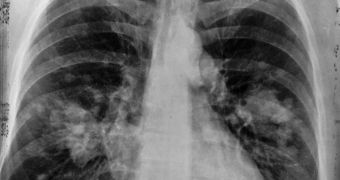South Korean scientists say that patients with lung cancer have high levels of a certain protein in their blood, and this could be used as a biomarker for the disease.
Je-Yoel Cho from Kyungpook National University and colleagues, conducted a research which concluded that the levels of the beta chain form of haptoglobin (a protein produced by the liver in case of disease) increased in blood samples containing lung cancer cells.
Current methods to detect cancer cannot give an early diagnosis, so Cho's team identified haptoglobin in human blood serum samples, and compared the protein levels in samples from lung cancer patients with those from healthy people.
The results showed that both groups had the same levels of the alpha form of the protein, but in lung cancer patients, the levels of the beta form were four times higher than in healthy people.
The researchers also compared lung cancer samples with other cancer types, and found that the levels of the beta form in other cancer types were similar to those in healthy samples, RSC reports.
Cho and his team said that this can only mean the beta chain increase could be used as a viable biomarker in detecting lung cancer.
Lung cancer is one of the most frequent forms of cancer, and it also has a mortality rate among the highest, according to data from the World Health Organization.
Early cancer detection is extremely important, if the patient is to have the highest survival chances, so finding a new biomarker for lung cancer is priceless.
But what could explain the high levels of beta chain in lung cancer patients?
The scientists say that since the beta chain is the only one to bind to glucose molecules in lung cancer blood sera, “it's possible that the glycosylated haptoglobin beta chain is more stable and has a longer half-life in lung cancer sera.”
Paul Huang from the Institute of Cancer Research, London, UK, explains that “since haptoglobin is an inflammatory response protein, it would be interesting to establish if assessing levels of the protein has additional prognostic value to patient outcome in response to treatment with conventional and targeted therapy.
“A biomarker panel incorporating the haptoglobin beta chain together with other previously identified lung cancer biomarkers may lead to a more powerful diagnostic test.
“This could allow scientists to distinguish different forms and stages of lung cancer using serum measurements,” added Huang.
Cho said that he and his team will keep looking for new lung cancer biomarkers, and for their future research they will use lung cancer tissue, primary cells, or their secretory proteins (that can be detected in sera or sputum).

 14 DAY TRIAL //
14 DAY TRIAL //